#mrs. maier
Explore tagged Tumblr posts
Text

Edmond Simpson 'Sunstroke' (Lichtenstein-Maier) v.1 (09-17)
78 notes
·
View notes
Text






🎄💾🗓️ Day 11: Retrocomputing Advent Calendar - The SEL 840A🎄💾🗓️
Systems Engineering Laboratories (SEL) introduced the SEL 840A in 1965. This is a deep cut folks, buckle in. It was designed as a high-performance, 24-bit general-purpose digital computer, particularly well-suited for scientific and industrial real-time applications.
Notable for using silicon monolithic integrated circuits and a modular architecture. Supported advanced computation with features like concurrent floating-point arithmetic via an optional Extended Arithmetic Unit (EAU), which allowed independent arithmetic processing in single or double precision. With a core memory cycle time of 1.75 microseconds and a capacity of up to 32,768 directly addressable words, the SEL 840A had impressive computational speed and versatility for its time.
Its instruction set covered arithmetic operations, branching, and program control. The computer had fairly robust I/O capabilities, supporting up to 128 input/output units and optional block transfer control for high-speed data movement. SEL 840A had real-time applications, such as data acquisition, industrial automation, and control systems, with features like multi-level priority interrupts and a real-time clock with millisecond resolution.
Software support included a FORTRAN IV compiler, mnemonic assembler, and a library of scientific subroutines, making it accessible for scientific and engineering use. The operator’s console provided immediate access to registers, control functions, and user interaction! Designed to be maintained, its modular design had serviceability you do often not see today, with swing-out circuit pages and accessible test points.
And here's a personal… personal computer history from Adafruit team member, Dan…
== The first computer I used was an SEL-840A, PDF:
I learned Fortran on it in eight grade, in 1970. It was at Oak Ridge National Laboratory, where my parents worked, and was used to take data from cyclotron experiments and perform calculations. I later patched the Fortran compiler on it to take single-quoted strings, like 'HELLO', in Fortran FORMAT statements, instead of having to use Hollerith counts, like 5HHELLO.
In 1971-1972, in high school, I used a PDP-10 (model KA10) timesharing system, run by BOCES LIRICS on Long Island, NY, while we were there for one year on an exchange.
This is the front panel of the actual computer I used. I worked at the computer center in the summer. I know the fellow in the picture: he was an older high school student at the time.
The first "personal" computers I used were Xerox Alto, Xerox Dorado, Xerox Dandelion (Xerox Star 8010), Apple Lisa, and Apple Mac, and an original IBM PC. Later I used DEC VAXstations.
Dan kinda wins the first computer contest if there was one… Have first computer memories? Post’em up in the comments, or post yours on socialz’ and tag them #firstcomputer #retrocomputing – See you back here tomorrow!
#retrocomputing#firstcomputer#electronics#sel840a#1960scomputers#fortran#computinghistory#vintagecomputing#realtimecomputing#industrialautomation#siliconcircuits#modulararchitecture#floatingpointarithmetic#computerscience#fortrancode#corememory#oakridgenationallab#cyclotron#pdp10#xeroxalto#computermuseum#historyofcomputing#classiccomputing#nostalgictech#selcomputers#scientificcomputing#digitalhistory#engineeringmarvel#techthroughdecades#console
28 notes
·
View notes
Text
"While we talked, a few flies would buzz around from the garden and Mrs. Harrison went to hit them. She said she couldn’t do that when George was there because he believed that everything had a right to live – no matter how small."
-- Susan Maier on meeting George Harrison's mother, Louise Harrison, in 1969. "A Special Day," Harrison Alliance (1979) [x]
#george harrison#louise harrison#the beatles#harrison alliance#this has been stuck in my head since i read it#fan encounters#1969#1979
180 notes
·
View notes
Text
Lost, but Not Forgotten: A Doll's House (1922)
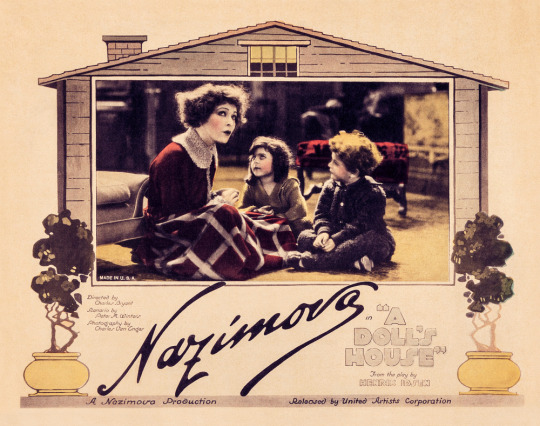
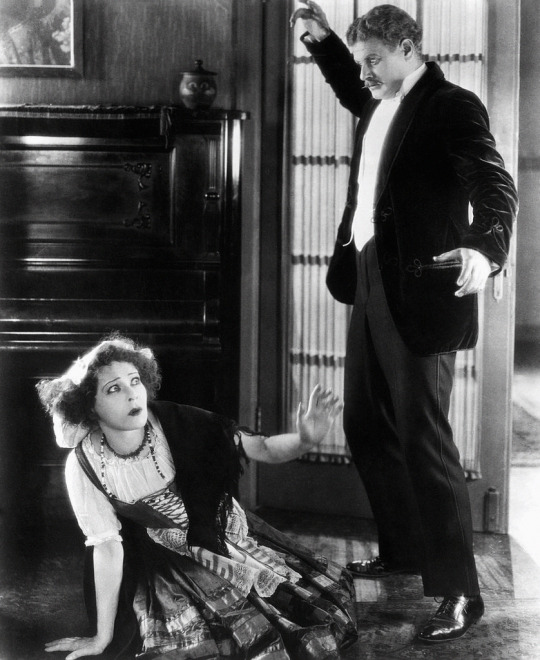
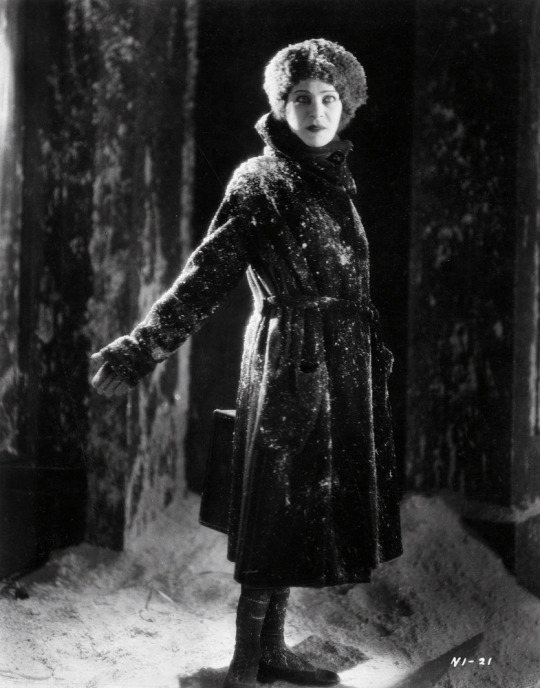
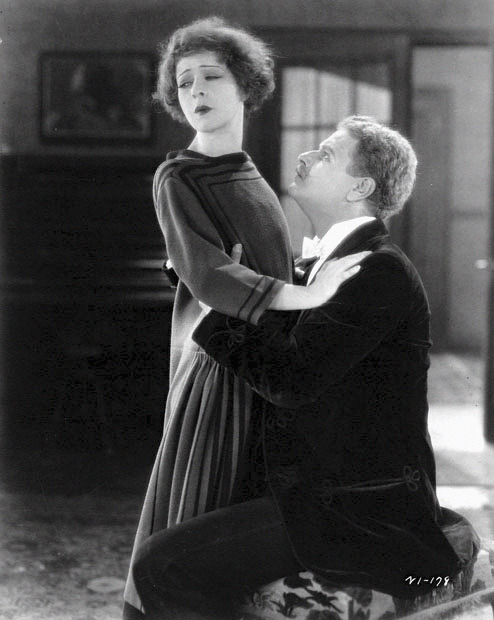
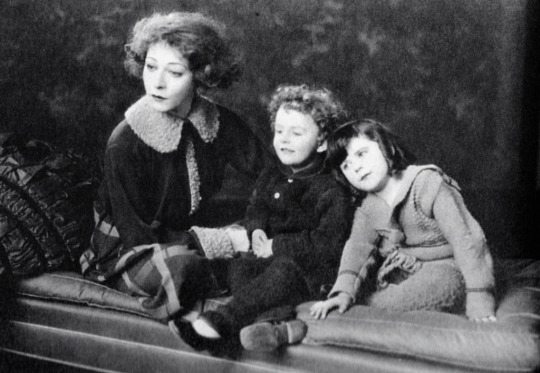
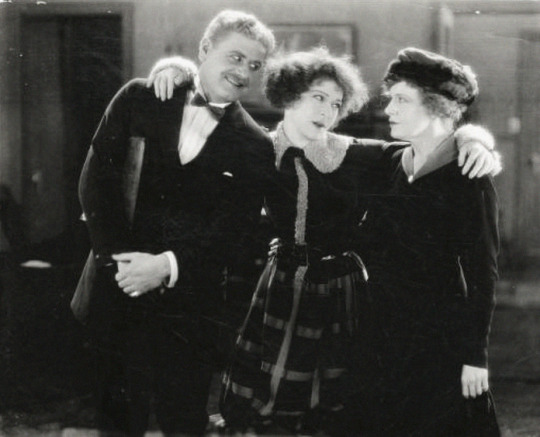
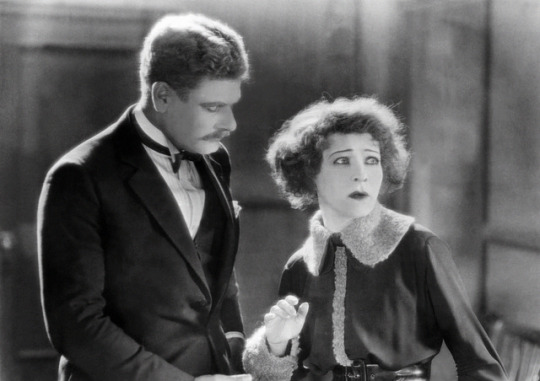
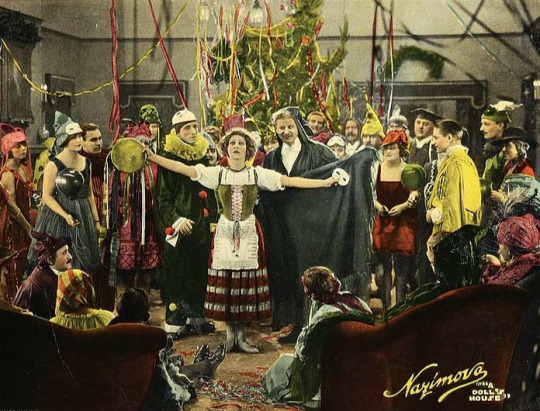
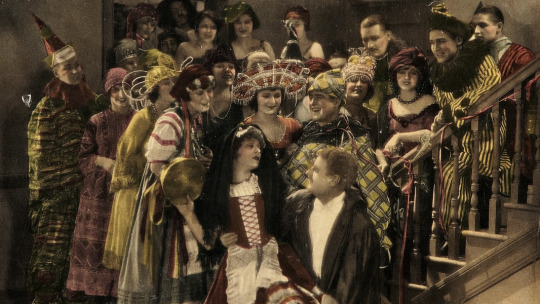
Direction: Charles Bryant; assisted by Albert Kelley
Scenario: Peter M. Winters (pen name of Nazimova)
Original Play: Henrik Ibsen
Camera: Charles Van Enger & Neal Jack (2nd camera); assisted by Paul Ivano & Lewis Wilson
Cutting: Lou Ostrow; assisted by Samuel Zimbalist
Wardrobe: Lilliam Turner
Studio: Nazimova Productions (production) & United Artists (distribution)
Performers: Nazimova, Alan Hale, Wedgewood Nowell, Nigel De Brulier, Florence Fisher, Clara Lee, Philippe de Lacy, Barbara Maier, Elinor Oliver
Premiere: Opening week: February 11-18, Strand Theatre, 1579 Broadway, Manhattan, NY and the Strand Brooklyn Theatre, 647 Brooklyn, NY.
Status: presumed entirely lost
Length: 7 reels or roughly 77 minutes
Synopsis (synthesized from magazine summaries of the plot)
In a comfortable flat, Nora Helmer (Nazimova) keeps house for her husband, Torvald (Hale), and their three children. Nora works hard to keep Torvald happy by playing the role of his “little squirrel.”
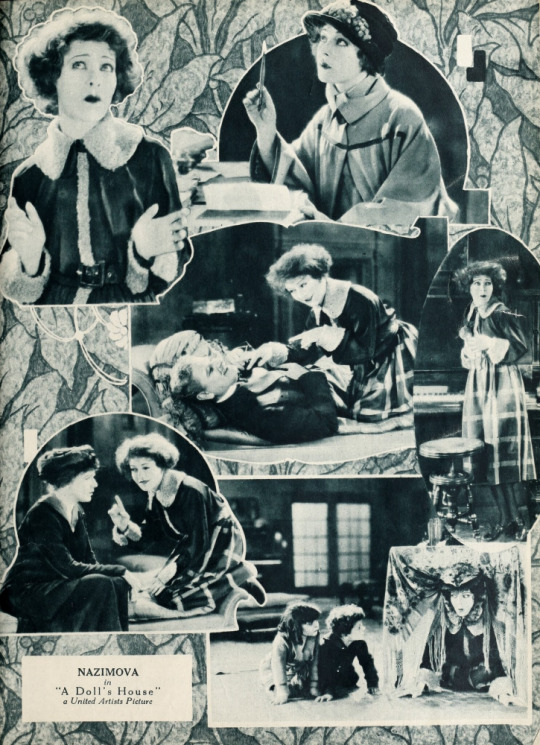
from Moving Picture World, 18 February 1922
Things were not always so comfortable for the Helmers, however. Three years prior, Torvald was gravely ill and the doctor ordered special treatment and a trip south to save his life. Nora secretly approached a money-lender, Krogstad (Nowell), to pay for Torvald’s treatment and forged her now-deceased father’s signature on a bond. In the intervening years, Nora has scrimped, saved, and taken in extra work to pay off the loan—still keeping the secret from her “principled” husband, who doesn’t approve of money-lenders.
Now, Torvald has fully recovered his health and Nora is one payment away from paying the loan in full. Torvald gets promoted to an official position at the bank and Krogstad now works under him. Upon learning that Krogstad has an unsavory past, Torvald decides to fire him—planning on offering his position to Nora’s childhood friend, Mrs. Linden (Fisher), who is now a single mother in need.
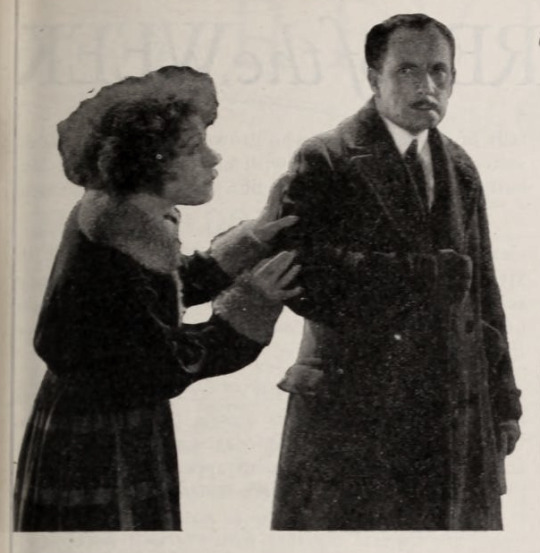
from Exhibitors Herald, 28 January 1922
Krogstad reveals to Nora that he knows she forged her father’s signature and that he will expose her to her husband if she doesn’t get Torvald to reinstate him at the bank.
Nora desperately tries to keep a cheerful, playful demeanor with Torvald. When Torvald sermonizes to her about moral turpitude due to bad mothers, she panics and feels her downfall is imminent.
Nora determines that she may be able to pay Krogstad off, and asks a family friend, Dr. Rank (De Brulier), for a loan. Unexpectedly, Rank takes this moment to confess his feelings for Nora. Nora rebuffs him, but now feels as though she has nowhere to turn.
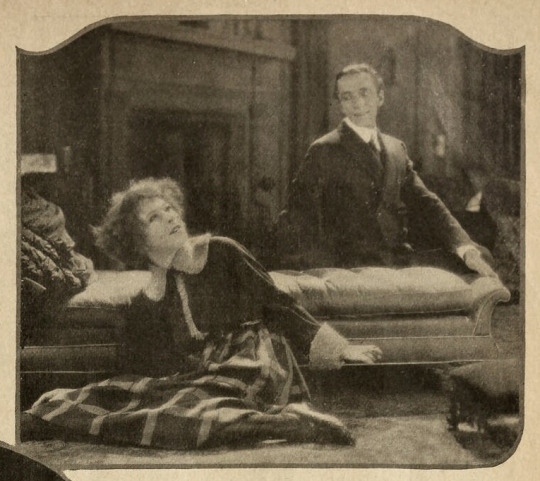
from Motion Picture Magazine, May 1922
On Christmas Eve, Nora knows that there is a letter from Krogstad in their post box, but only Torvald has a key. Nora frantically distracts him from opening the box before they leave for a holiday masquerade party. Torvald notices Nora’s frenetic energy in how she dances at the party, but doesn’t know the cause.
When they return home, Torvald retrieves the mail. Before he can open the letter from Krogstad, Nora confesses that she deceived him to save his life. Torvald is furious that Nora has endangered his reputation and questions if she is fit to be a mother while in the same breath stating that he will pay Krogstad off.
However, when Torvald opens the letter, his mood turns on a dime. Krogstad has had a change of heart due to the influence of Mrs. Linden, who also happens to be an old sweetheart of Krogstad’s. The letter contains the cancelled note. Torvald grabs Nora and dances her around the room, overjoyed that his reputation is no longer in danger.
Nora realizes all of her acrobatics (literal and metaphorical) to keep Torvald happy have been pointless. She has sacrificed so much of her energy and independence to merely become “a toy of a selfish man.” The mask has fallen. While Torvald is ready to pretend that nothing has changed, Nora knows that she cannot go back to being his doll. Nora packs up her belongings and leaves the flat—intent on becoming her own person.
Final title card: “The End, or, Rather the Beginning.”
---
Points of Interest:
A Doll’s House (1922) was Nazimova’s first independently produced film after her contract with Metro ended.
Some of Nazimova’s first roles on the American stage were Ibsen plays (“Hedda Gabler,” “A Doll’s House,” & “The Master Builder,” to be specific), so this film was an attempt to capture some of that work on film.
Only 8 out of Nazimova’s 18 silent films survive today and only 3 have been made available on home video or streaming. [I recently re-watched Salome (1922) on the Pioneers: First Women Filmmakers set and I can’t recommend picking up this set enough!]
All Nazimova Silents:
“War Brides” (1916, presumed lost)
“Revelation” (1918, extant at MGM)
“Toys of Fate” (1918, extant at Národní filmový archiv)
“A Woman of France” (1918, short, presumed lost)
“Eye for Eye” (1918, extant at Gosfilmofond)
“Out of the Fog” (1919, presumed lost)
“The Red Lantern” (1919, extant at Cinémathèque Royale de Belgique, Gosfilmofond)
“The Brat” (1919, presumed lost)
“Stronger than Death” (1920, extant at MGM & Eastman House)
“Heart of a Child” (1920, presumed lost*)
“Madame Peacock” (1920, extant at Cinémathèque Royale de Belgique)
“Billions” (1920, presumed lost)
“Camille” (1921, extant)
“A Doll’s House” (1922, presumed lost)
“Salome” (1922, extant)
“Madonna of the Streets” (1924, presumed lost)
“The Redeeming Sin” (1925, presumed lost)
“My Son” (1925, presumed lost)
*The Women Film Pioneers Project website has this film listed as extant at Cinémathèque Royale de Belgique, but LOC lists it having no known archival holdings.
[Survival status checked via LOC’s Silent Feature Film Database, and re-checked at relevant archives when available]
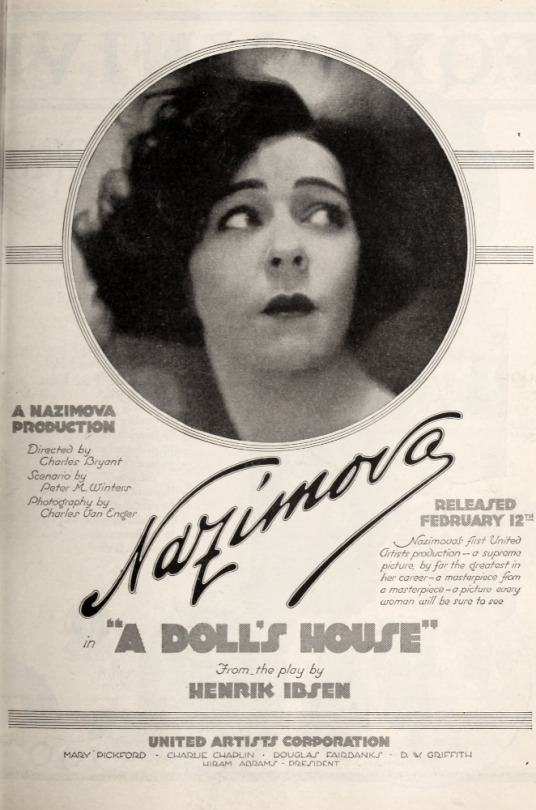
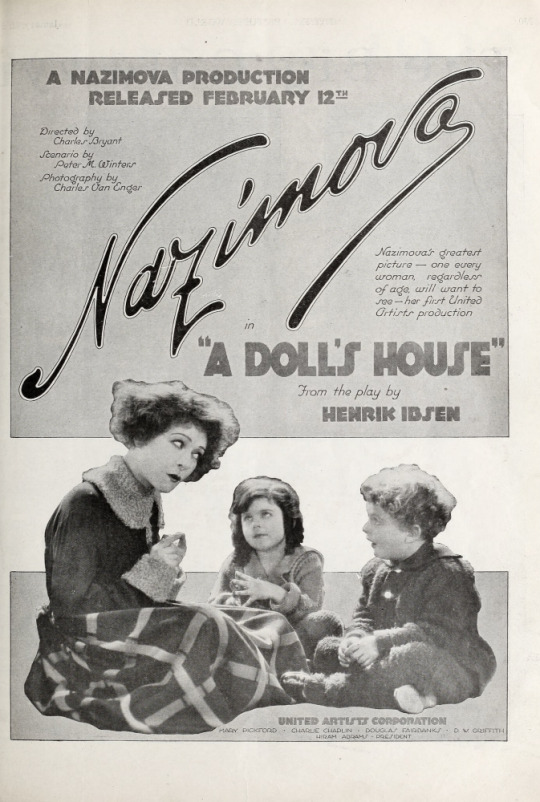
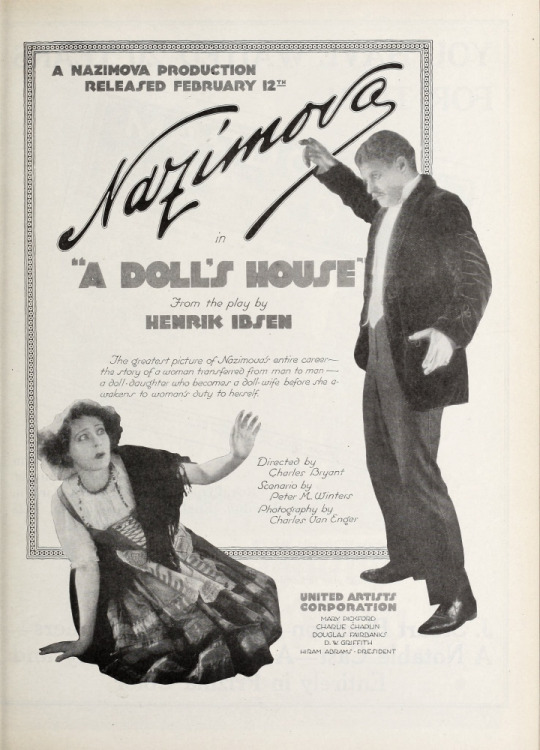

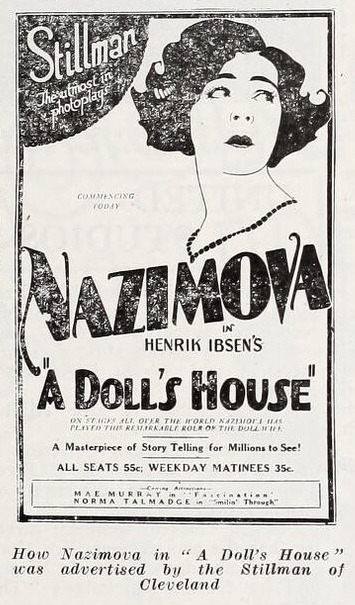
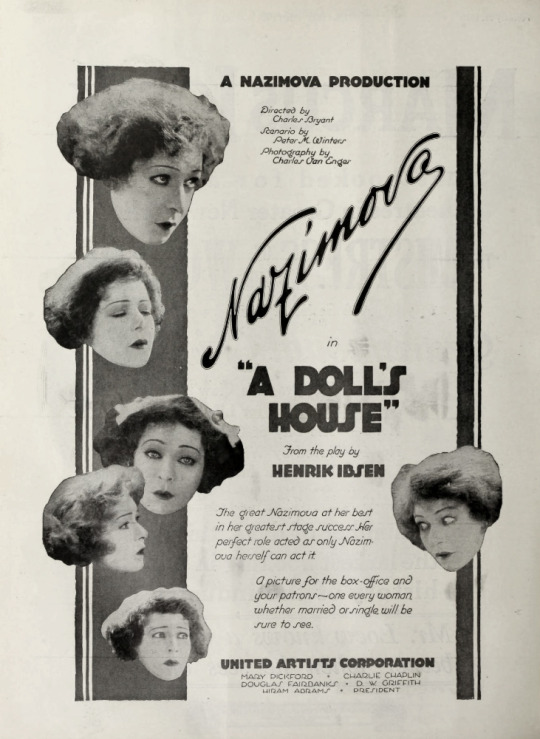
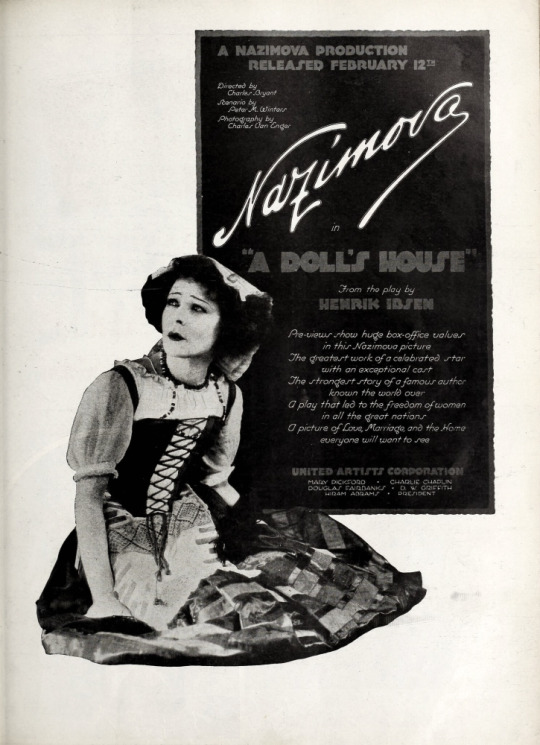
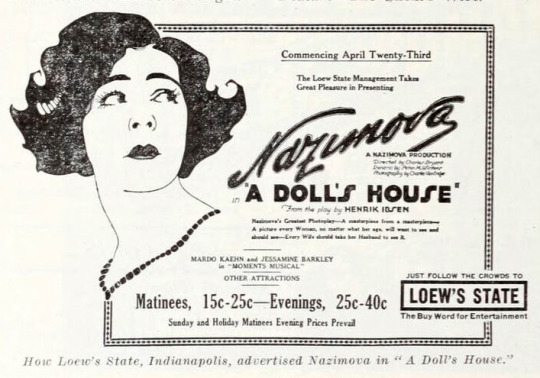
Transcribed Sources & Annotation over on the WMM Blog!
Buy me a coffee!
#Nazimova#Alla Nazimova#henrik ibsen#1920s#1922#silent era#silent movies#silent film#american film#independent film#charles bryant#a doll's house#film#movies#classic film#classic movies#film history#lost but not forgotten#lost film
37 notes
·
View notes
Text
S10:W13
Seasoned readers of the LOG weekly write ups know that my write ups are a mixture of sports, personal reflection, politics, romance, life advice and cries for help. But no matter what the subject matter, I think you all know that every single write up is baked in truth, well, mostly truth. I preface this because when I tell you that winning a game in the LOG makes me happy, it literally brings me joy. No, it’s more than joy, it brings me relief, a peace to be more accurate. I spend most Sundays not checking my scores until well into the afternoon. I load the app, get a glance of the score, decide if I’m getting fucked or fucking someone, then, I shut it down. But when I see that green prediction bar sitting at 90% with only a few players left, I literally relax in my soul. I light up. I try to talk to my wife about it, but I don’t get the reaction that it deserves. It’s one of like 3 things in my life that I actually feel in my heart of hearts. No bullshit. Is something wrong with me? Or maybe if you don’t feel this way, something is wrong with you. This week's Petey password is worth a whopping fifty bones, no joke. If I receive a text from him with the password: “stinky pinky”, his venmo account will get fifty dollars richer. I guess the point is that this league, this community, this brotherhood is god damn close to all I really care about in this life. Last night I lied on top of my bed postcoital with my hands behind my head staring up at the ceiling. My heart was still pumping out of my chest from the cardio and I was dressed with only a shit eating grin. The Mrs had already waddled to the bathroom trying to hold in about a million little sperm babies when a thought came into my clear conscience. I uncrossed my toes, giggled, shook my head and with my lungs still on fire, I said out loud “big dick of the fuckin week.” Life. Is. Good.
Kick back with a microdose boys, a heavy microdose.
LOG 4 life!
~mish
LOG WEEKLY DICK SIZE RECAP
Max Marple has the BIG DICK OF THE WEEK: 131 Points
Chris Raj has the small dick of the week: 68 Points
Shawn House has THE THROBBER - 190.64 (S9:W3)
Ethan App has the STINKY DICK - 48.14 Points (S10:W7)
SEASON X BIG DICKS OF THE WEEK - $100
Sarnia Slut Slayers 4
Odusty Beckham Jr. 3
DISCIPLINE = FREEDOM 2
Embarcadero Burd Turds 1
Papi Gringos 1
Sordidus 1
Spirit Halloween/OTS 1
Big Sur Buckle Nuggets 0
Redfield 49Knerrs 0
The Raj Hotel 0
BIGGEST DICK OF THE YEAR - $100
ODusty Beckham Jr - 177:Week 2
LOG CHANGES FOR 2025
We are going back to our roots for draft day. We are going old school. Clip boards, paper and pens at the draft. No more phones or tablets to assist in the draft. Now I know the value in these modern gadgets. But I don’t want to see guys annoyed or upset that their gadget might get ruined by a pool dunk or a champagne squirt. I don’t want to see “Roman” avoiding the sticker board because he is catching up or having trouble with his app. We put them away, we do paper and pen, we try to pay attention, it’s a shit show, if we find a violation, we will penalize accordingly, loss of keeper, loss of FAB or something. Clipboard, trunks and a positive attitude is all you need to bring to draft day moving forward!
Loser of the league will sing the national anthem to kick off the following draft. (after the maier/hames bet is final)
The LOG is moving to the SLEEPER app in 2025
Draft weekend is now 2 weekends before Labor Day. Not the weekend before labor day, but the one before that.
The throbber and stinky dick will be retired. There will be some other rule tweaks that affect scoring and those will be retired
The LOG championship belt will also be retired after year 10. LOG 2.0 will have a new belt and the old will be present for photos at draft weekends (not for losers).
2 notes
·
View notes
Text
Interview with Sepp Maier
By:Sport1

Mr. Maier, how do you look back on the football year 2023?
With a lot of emotion. It started with Manuel Neuer's serious injury, which he sustained on his skiing vacation. That was a shock, of course. But one thing is clear: Manu never took too many risks. I never doubted Manu's comeback afterwards. He's such a great goalkeeper, he just had to come back. Of course, it was sad when FC Bayern parted ways with Julian Nagelsmann. It came as a surprise, but perhaps it was unavoidable. Overall, it wasn't FC Bayern's year.

The Munich team also said goodbye to leading personalities prematurely. Looking back, how do you view the departure of Hasan Salihamidžić and Oliver Kahn?
Of course, that was a big personnel shake-up. Brazzo tore himself apart for FC Bayern, I'm sure of that. And maybe Olli didn't fit into the manager's chair. He certainly gave his all for the club, because he has a deep red Bayern heart. The way Uli settled accounts with Olli afterwards was certainly not good. That was Uli at his best again.

What was your personal highlight?
Manu's return in the home game against Darmstadt 98 is clear. I never understood the whole drama, nor why other goalkeepers were traded in the first place. And my opinion of Yann Sommer is well known: I would never have signed him. I'm happy for him that he's now performing so well again at Inter Milan. But Sommer wasn't one for FC Bayern. A small highlight was certainly the double contract extension of Manuel Neuer and Sven Ulreich recently. FC Bayern showed its old strength. That was a great move.

For the first time in many years, FC Bayern is not first at the end of the year, but sees Bayer Leverkusen at the top of the table. How much does that make your Bayern heart ache?
That hurts a bit - and it's also really unusual. But it has to be acknowledged without envy that Leverkusen deserve it. They have set a new record with 25 unbeaten competitive matches across all competitions, which is quite a remarkable run. Xabi Alonso would be a great coach for FC Bayern, he's doing an excellent job at Leverkusen. The way football is played there makes every fan click their tongue. It's unparalleled even in Europe. And honestly? I wouldn't have put it past Alonso.

Will Leverkusen even become German champions in the end?
I still believe that Bayern will be champions again in the end, but it hasn't been as difficult as this season for a long time. Thomas Tuchel must get the players back on track immediately in the new year. Bayern must not weaken for a single minute. Otherwise that's it for the title. But there are also quite a few people who would begrudge Bayer Leverkusen the title. If only because of Alonso. That would also put an end to this stupid "Vizekusen" (second-kusen or also his english equivalent neverkusen)
Thomas Müller has extended his contract with FC Bayern until 2025 ahead of the last game of the year. It wasn't a complete surprise, how did you take it?
With great joy. But I also firmly assumed that Thomas would stay, he's simply a Bayern legend. Müller is such a good guy and a really good player. The way he performs on and off the pitch is wonderful and I pay him a lot of respect for that. Müller hasn't always had it easy with Tuchel, but he's taken it professionally. I'm sure Tuchel also liked his attitude. Thomas Müller lives and breathes FC Bayern. The interview after the 3-0 win against VfB Stuttgart was 100 percent Müller. He was funny and totally clear with what he said. You can't imagine him at any other club anyway. Like with me back then.
Is Müller the Gerd Müller of today?
Absolutely. Thomas Müller is the Gerd Müller of modern times. There's nothing more to say. Gerd would be proud that Thomas has extended his contract again.
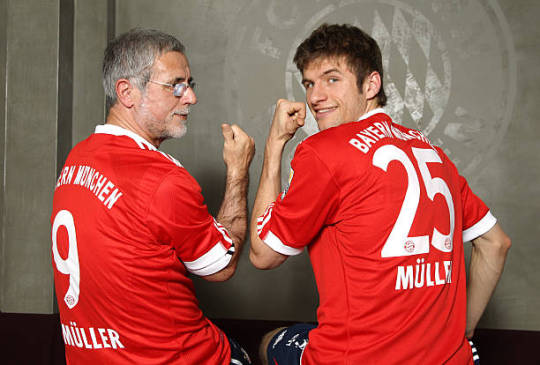
What makes Müller so unique?
His professionalism and his authentic and funny manner. I can only repeat myself: he's just a really good guy and a great footballer.
But Müller will probably replace you as the record player - does that annoy you?
Not at all. I'd rather have Thomas than someone from BVB (laughs). It will happen and he is a worthy successor. I wish him all the best. He will have earned it.
Harry Kane has scored 21 goals in 15 league games. An incredible rate, isn't it?
Absolutely. In the summer, you could assume that things would work out with him and Bayern, but his performance is already exceptionally good. There are almost no words. The special thing about Kane is that he also works for others and shows how much he has already internalized FC Bayern. He's good for the Bundesliga. Kane is clearly more valuable than Lewandowski.

Finally, let's take a look ahead to next year's European Championship at home. What are your thoughts on the tournament?
I have mixed feelings about the home European Championships. Of course it's something very special. And it will be a very important tournament, especially for Julian Nagelsmann. He can win everything, but he can also lose everything. One thing is clear: the team must improve. We won't get through the preliminary round with performances like the recent ones against Turkey and Austria. Then we'll fail badly, but I'm thinking positively. The closer we get to the European Championship, the more euphoria there will be in Germany. It will be similar to 2006.
Julian Nagelsmann recently hinted in the ZDF sports studio that he could imagine bringing Toni Kroos back to the national team. What is your opinion?
I wouldn't bring Kroos back. I don't think it's good for him to play for the national team again. He's had his time. We have many other talented players in his position who can help the team. It's a popular topic for the media, but I wouldn't call Kroos up again. That doesn't mean he's not a great player and hasn't done anything for German football.

Meanwhile, Marc-André ter Stegen is fighting for the number one spot in the German national team, but is currently injured. Who will be in goal for Germany at the European Championships?
Manuel Neuer. Ter Stegen is a very good goalkeeper, but Manu is on the way to his old form, so there is no doubt who will be number 1 at the European Championship in Germany.

Final question: After 17 months of proceedings, the European Court of Justice has given the green light for the establishment of the Super League. Are you pleased about this?
Of course not. Nobody needs the Super League, there is already the Champions League for the big clubs, many national leagues and then the Nations League. The Super League will turn football into a two-tier society. I see that with great concern.
#sepp maier#manuel neuer#xabi alonso#bayer 04 leverkusen#fc bayern münchen#thomas müller#gerd müller#harry kane#german nt#toni kroos#interview
12 notes
·
View notes
Text
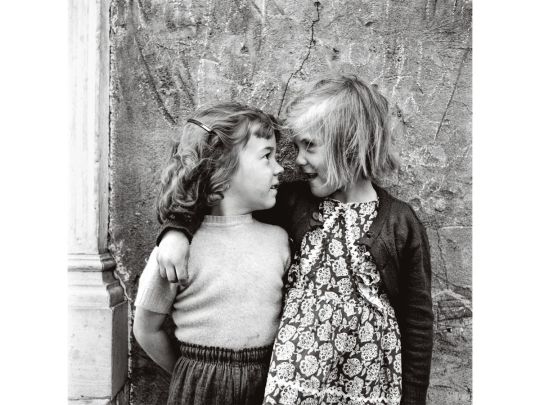
Ph.Vivian Maier
"Tout ce qui excède en intensité, en présence, en saveur, laisse un reste."
Sylvie Germain "Petites scènes capitales"
Cliché stupéfiant qui me retourne au temps de C. et moi et notre amitié ou plutôt notre amour extraordinaire de gamines. C. était (est toujours puisqu'elle est devenue professeur de musique) une mélomane clarinettiste passionnée, petite mirguette gentille et malicieuse, toujours gaie, malgré un bec de lièvre dont elle ne se plaignait jamais. Au primaire, en CM2, dans notre minuscule village de campagne, les onze filles et le seul garçon de la classe, jouions toutes ensemble (excuse-moi Charles mais là le féminin l'emportais clairement sur le masculin) avec une grande complicité et tellement d'entrain.
Arrivées au collège et à cause de l'éclatement de notre groupe, tout à changé... Les quatre années terribles nous sont tombées sur le coin du museau à C et moi. Surtout à C d'ailleurs, c'est le cas de le dire.
Les réseaux sociaux n'ont pas inventé le harcèlement; ils n'ont rien inventé d'ailleurs, juste amplifié la chose.
C. a subi tous les outrages de la part des élèves du collège Louise Michel (Filles comme garçons mais surtout filles dont deux très acharnées, en l’occurrence S. une de ses anciennes "amies" de l'école) parce qu'un ange avait posé un doigt en travers de sa bouche juste avant sa naissance.
Elles et ils la traitaient de tous les noms d'oiseaux (j'ai lu ici un jour, un thérapeute reprendre les mots de Freud : « Le premier homme à jeter une insulte plutôt qu'une pierre est le fondateur de la civilisation. ») Mais oui bien sûr !! ça m'a fait bondir d'indignation. Tu ne jetteras ni l'une ni l'autre ni avant ni après ni pendant, ni jamais. Elle, C. elle avait les deux en prime. Bousculades, on venait nous marcher sur les jambes quand nous prenions le soleil, assise contre le mur. J'ai giflé violemment un jour une grandasse de 3ème parce qu'elle avait fait tomber C. du banc pour lui prendre sa place. C. ne se défendait pas, elle était incroyablement timide, apeurée. Et moi, j'étais ivre, secouée tremblante de colère, de fureur, car les adultes, professeurs comme parents VOYAIENT cela, ce qui se passait et aucuns ne levaient le petit doigt.
Sauf, Mr B. notre professeur de français... Il nous a demandé un jour de faire une rédaction sur le thème de l'amitié... J'ai écrit sur la nôtre à C. et moi et puis il m'a mis la meilleure note et l'a lue à toute la classe de 3ème. Je me souviens du silence ensuite. Seulement de cette suspension claire de sons, baignée de soleil qui rentrait à flots par les baies vitrées du préfabriqué. Un grand et beau mutisme, bien épais comme après un K.O sur un ring de boxe. Au ralenti. C. et moi assises côte à côte, on se regardait en douce, en souriant, se touchant la main...
Plus rien n'a été comme auparavant depuis ce jour de juin. La tempête a enfin quitté la mer. Grâce à l'intervention subtile, fine, intelligente, de notre professeur de français. Merci Monsieur B.
Beaucoup. Énorme aimant. A jamais.
9 notes
·
View notes
Note
(This is @steddie-there )
42 and 69 for the asks to get to know each other!
hihi!!
42. What is your favourite movie? god okay i was so excited about this question here we go: 1) Sing Street; go watch it rn it’s so beautiful like the cinematography is incredible and the themes are gorgeous and the acting is fantastic it’s so good pls watch it; coming of age, non-conformity and rebellion, falling in love, this baby has it all 2) Coraline; i have it basically memorised i’ve watched it literally countless times i have a serious problem 3) Live Is Life; fucking phenomenal; ‘how i love being a woman’ but for boyhood; coming of age kind of, healthy friendships between boys, loyalty and affection and gorgeous cinematography 4) Finding Vivian Maier; this one’s a documentary but it’s amazing 5) Fantastic Mr Fox; i want to be a wes anderson film and im pretty sure ash formed an integral part of my personality ('there's a lot of attitudes going on around here... don't let me get one.' come on)
69(heheh). Do you play any instruments? unfortunately no :( i played piano when i was little but gave up when we moved away and then i did guitar for a while in high school but stopped bc i started taking it as a class and started to hate it (i still have a guitar and i’ve been meaning to learn to play it again but i haven’t yet)
cute asks!!
2 notes
·
View notes
Text
I am a near-native, fluent English speaker all without your help! I learned this fucked up language all through social media and the coolest teacher imaginable (thanks Mrs. Maier)
I won't let anyone, not even an oilf, talk down on this beautiful skill I aquired through hard, hard work
100k notes and i'll @ my crush on this post
148K notes
·
View notes
Text
A devoted wife and mother leads a secret life as a CIA agent until her husband’s article exposes a scandal, putting her identity and loved ones at risk. As her world crumbles, she must navigate the fallout of her double life. Credits: TheMovieDb. Film Cast: Valerie Plame: Naomi Watts Joseph Wilson: Sean Penn Sam Plame: Sam Shepard Bill: Noah Emmerich Jack: Michael Kelly Jim Pavitt: Bruce McGill Scooter Libby: David Andrews Paul: Tim Griffin Dr. Zahraa: Liraz Charhi Hammad: Khaled El Nabawy Chanel Suit: Sonya Davison Tabir Secretary #1: Vanessa Chong Hafiz: Anand Tiwari Tabir Secretary #2: Stephanie Chai Fred: Ty Burrell Sue: Jessica Hecht Steve: Norbert Leo Butz Lisa: Rebecca Rigg Diana: Brooke Smith Jeff: Tom McCarthy Samantha Wilson: Ashley Gerasimovich Trevor Wilson: Quinn Broggy CIA Tour Leader: Nicholas Sadler CPD Agent: Iris Bahr Minister of Mines – Niger: Ghazil Joe Turner: Kristoffer Ryan Winters Nervous Analyst #1: Louis Ozawa CIA Analyst #1: Sean Mahon Professor Badawi: Mohamed Abdel Fatah Kim: Rashmi Rao Nervous Dave: David Denman Nervous Analyst #2: Remy Auberjonois Ali: Sunil Malhotra Jordan Officer #1: Kevin Makely Mukhabarat Officer: Mousa Al Satari Hammad’s Son: Rafat Basel Hammad’s Wife: Maysa Abdel Sattar B.U. Professor: Judith Resnik B.U. Student #1: Ben Mac Brown B.U. Student #2: Satya Bhabha Iraqi Scientist #1: Nabil Koni Iraqi Scientist #2: Mohammad Al Sawalqa Beth: Jenny Maguire Pete: David Warshofsky Ari Fleischer: Geoffrey Cantor Journalist #1: David Ilku Journalist #2: Deidre Goodwin Journalist #3: Donna Placido Karl Rove: Adam LeFevre Steven Hadley: Brian McCormack Andrew Card: James Rutledge Cathie Martin: Tricia Munford David Addington: Michael Goodwin Mr. Tabir: Nassar Dir. of CIA Operations: Chet Grissom Internal Security Officer: James Joseph O’Neil Supporter #1: Danni Lang Supporter #2: Jane Lee Field Reporter #1: James Moye Field Reporter #2: Judy Maier Diane Plame: Polly Holliday Businessman #1: Kola Ogundiran Businessman #2: Byron Utley Right Wing Reporter: Anastasia Barzee DC Cab Driver: Sanousi Sesay Barista (uncredited): Angela Lewis Deceased Soldier’s Daughter (uncredited): Michelle E. Mancini UN Diplomat (uncredited): Rebekah Paltrow Neumann Iraqi Server (uncredited): Barbara Grace Romano Four Seasons Waitress (uncredited): Satu Runa Warehouse Supervisor (uncredited): Kaipo Schwab Head Paparazzo (uncredited): Harry L. Seddon Turkish Diplomat (uncredited): Kent Sladyk Vietnam Vet at Rally (uncredited): Bill Walters Film Crew: Producer: Doug Liman Screenplay: John-Henry Butterworth Producer: Jez Butterworth Book: Joseph Wilson Associate Producer: Sean Gesell Makeup Department Head: Michal Bigger Line Producer: Pete Singh Key Hair Stylist: Amanda Miller Line Producer: Anadil Hossain Line Producer: Bruce Wayne Gillies Line Producer: Carson Ng Original Music Composer: John Powell Executive Producer: Mohamed Khalaf Al-Mazrouei Associate Producer: Gerry Robert Byrne Line Producer: Wesam Seif Elislam Hairstylist: Lisa Hazell Book: Valerie Plame Executive Producer: Jeff Skoll Co-Producer: Avram Ludwig Stunt Coordinator: G. A. Aguilar Stunt Coordinator: Peter Bucossi Co-Producer: Kim H. Winther Casting: Joseph Middleton Producer: Bill Pohlad Co-Producer: David Sigal Producer: Janet Zucker Set Decoration: Sara Parks Executive Producer: David Bartis Executive Producer: Mari-Jo Winkler Costume Design: Cindy Evans Producer: Jerry Zucker Editor: Christopher Tellefsen Stunts: Anthony Vincent Producer: Akiva Goldsman Art Direction: Kevin Bird Production Design: Jess Gonchor Stunts: Stephen A. Pope Executive Producer: Kerry Foster Movie Reviews:
#central intelligence agency (cia)#duringcreditsstinger#iraq#nuclear scientist#politician#Top Rated Movies
0 notes
Text
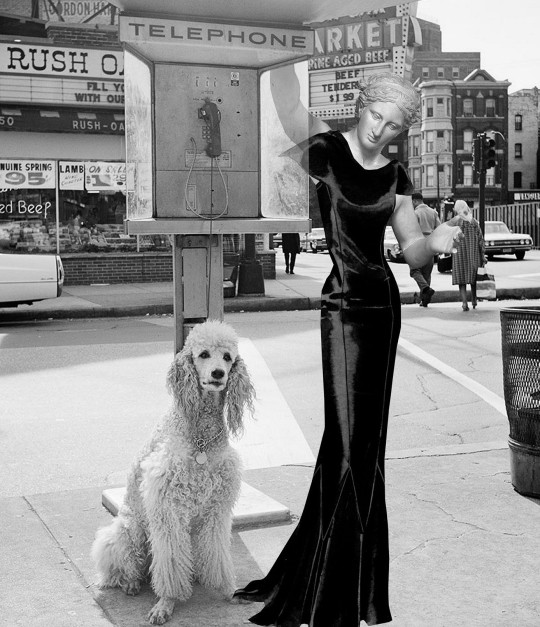
Edmond Simpson 'New Found Friend' (Maier-Vogue)
18 notes
·
View notes
Text
Vivian Maier: The Creative Personality Versus the Persona

— Written by: John Paul Jonas
In New York, the retrospective of Miss Vivian Maier (1926-2009), titled “Unseen Work,” recently concluded. The exhibition was open to visitors from May 31 to September 29, 2024, at the “Fotografiska New York” museum. The showcase included around 230 works covering the period from the early 1950s to the late 1990s, featuring many previously unseen photographs.

The exhibition highlighted Miss Maier's distinctive style and her extraordinary ability to capture the essence of everyday life through an artistic lens. It is part of a larger effort to bring her work to a wider audience, especially considering that her vast body of work was only discovered posthumously, yet it is already considered one of the most important contributions to 20th-century photography.
Organized in partnership with cultural institutions such as the John Maloof Collection in Chicago and the Howard Greenberg Gallery in New York, this retrospective is part of an international tour that began in Paris in 2021.

Over the past 15 years, since the discovery of her archive, Miss Maier’s remarkable life story has captivated the international art community. Why?
Miss Maier was an American street photographer of French descent, born in 1926 in New York. She spent most of her life working as a nanny in Chicago. During her time off or on walks with the children she cared for, she dedicated herself to photographing the urban life around her, capturing candid and unfiltered moments of city life.

Although she remained unknown during her lifetime, her extensive archive—comprising over 150,000 negatives—was discovered in 2007 when Mr. John Maloof acquired the majority of her work at an auction. Fascinated by his discovery, Mr. Maloof became the driving force behind promoting her photographs, leading to the production of the Oscar-nominated documentary Finding Vivian Maier in 2013. Since then, interest in her extraordinary life and work has only grown. Following years of research, two comprehensive biographies have been published: Vivian Maier: A Photographer’s Life and Afterlife by Pamela Bannos in 2017 and Vivian Maier Developed: The Untold Story of the Photographer Nanny by Ann Marks in 2021.
In his renowned work On Liberty, John Stuart Mill reminds us: “Among the works of man, which human life is rightly devoted to perfecting and beautifying, the first in importance surely is man himself.” This observation aptly applies to the life and work of Miss Vivian Maier.

Anne Morin, curator of the exhibition Vivian Maier: A Photographic Revelation, shown across Europe, claims that Miss Maier is “one of the top street photographers, ever.” “Her story is definitely amazing, but I have to work hard to keep it separate from the physical reality of her photographs.” (Morin, as cited in Casper, 2014) [1] While I have no doubt about the sincerity of this intention, I fear such efforts may be in vain. Miss Maier’s most significant achievement is, indeed, her extraordinary life story. The art of photography forms the backbone of this narrative. It gave meaning to an otherwise unremarkable life—perhaps the highest gift art can bestow upon its creator.
“When we are involved in [creativity], we feel that we are living more fully than during the rest of life,” observes Professor Mihaly Csikszentmihalyi, adding, “Even without success, creative persons find joy in a job well done.” [2] For an artist, separation from their art is a kind of torment, a confrontation with the meaninglessness of existence. When Miss Maier’s photographic walks ended in success, her daily duties as a nanny likely became less tedious and futile. The world’s imposed tasks could be viewed as necessary preparations for the next round of creation. A reasonable compromise.

Professor Csikszentmihalyi also suggests that no one can be both exceptional and normal at the same time. Miss Maier separated these two aspects of her life for the sake of survival—a creative compromise. For those around her, including the families she worked for, she presented herself as an unmarried yet proud modern woman, unusually interested in various aspects of contemporary life. “The personal accounts from people who knew Vivian are all very similar. She was eccentric, strong, heavily opinionated, highly intellectual, and intensely private. She wore a floppy hat, a long dress, wool coat, and men’s shoes and walked with a powerful stride.” [3]
Well-informed and empathetic toward the oppressed, she was diligent in imparting knowledge to her charges, often addressing challenging topics. Their walks included visits to impoverished parts of the city, with open discussions about current issues. Some audio recordings of these conversations, conducted in the form of interviews, were found among the artist's belongings. Similar efforts are confirmed by Mrs. Nancy Gensburg of Highland Park, whose three sons (John, Lane, and Matthew) were cared for by Miss Maier: “She wanted them to be very aware of what was going on in the world.” [4]

The artist’s identity intertwines significantly with her role as a caregiver, a profession that financially sustains both sides of her life. This unusual nanny finds ways to navigate the demands of daily life. At this stage, the dichotomy between her two personas isn’t yet fully expressed. It even seems that, in a harmonious blend, the creative personality might enrich the life and professional standing of the governess. As a photographer, she grants herself permission to dedicate valuable time, energy, and resources to a project that, at the very least, jeopardizes the practical survival of her career as a childcare provider. Always seeking knowledge and intellectual challenges, the artist approaches her vocation with both dedication and apparent detachment. “She captured politicians on the campaign trail (Eisenhower, Kennedy, Nixon, LBJ); celebrities at premieres or out in the wild (Frank Sinatra, John Wayne, Greta Garbo, Audrey Hepburn); laborers and commuters; drunks, criminals, and down-and-outs; flâneurs [*] and well-coiffed women in furs”. [5]

The initial enthusiasm seems well-balanced and clearly directed. The financial support that Miss Maier manages to secure through her profession as a governess is apparently supplemented by a modest family inheritance. It appears that resources to fuel her creative spark are not lacking—quite the opposite. She frequently takes advantage of opportunities for extensive travel, during which she further broadens her intellectual horizons. These odysseys stand in stark contrast to the otherwise modest habits of the nanny. “Her thirst to be cultured led her around the globe. At this point we know of trips to Canada in 1951 and 1955, in 1957 to South America, in 1959 to Europe, the Middle East, and Asia, in 1960 to Florida, in 1965 she’d travel to the Caribbean Islands, and so on. It is to be noted that she traveled alone and gravitated toward the less fortunate in society”. [3] The families she worked for generally viewed such excursions with leniency, tolerating the whims of their young, unmarried, and headstrong caregiver. “If she wanted to go, she’d just get up and go,” Nancy recalls. “The family would hire a temporary replacement while Maier was away; she never said where she was headed”. [4]

During her creative expeditions across the globe, Miss Maier photographed tirelessly. It is likely that during this period of intense travel and creative freedom, a strong artistic personality fully took shape. The desire for unrestricted movement and an independent choice of vocation remained powerful even upon her return to the role of governess. The families she worked for began to sense a shift in her approach to daily duties; unfortunately, the other Miss Maier—sensitive, original, and above all, productive—became inaccessible, even to those closest to her. “She really wasn’t interested in being a nanny at all,” Nancy Gensburg says. “But she didn’t know how to do anything else.” [4] The second part of this statement now seems both untrue and harsh. Many creative individuals who were not recognized in their own time face similar misconceptions. In Miss Maier’s case, we ask ourselves to what extent the artist herself is responsible for hiding her achievements from public view.
Based on the relatively sparse evidence currently available, we conclude that Miss Maier’s early creative work was far more visible and accessible, at least to those in her immediate surroundings. “There’s one family in New York that has hundreds of vintage Vivian photographs. In Chicago, she’d give people like two at the most. So she was much more generous and open with her photography in New York.” (Marks, as cited in Reid, 2021) [6]

It is evident that the pressures of daily life grew stronger with time. The creative personality would occasionally retreat, and the artist often made concessions. For example, in her creative process, she gradually abandoned post-production. The selection and processing of photographs, printing reproductions, and even developing negatives became increasingly unavailable luxuries. “In 1956, when Maier moved to Chicago, she enjoyed the luxury of a darkroom as well as a private bathroom. This allowed her to process her prints and develop her own rolls of B&W film.” [3] This convenience extended her control over the creative process—from capturing the image to developing the prints. The initiative of transforming her bathroom and sacrificing personal comfort demonstrates her deep commitment to accessing resources scarce for an artist in the social role of a nanny. Miss Maier consistently exhibited an undeniable dedication to learning, refining her artistic methods, and perfecting her technique. It wasn’t merely an exploration of her own vision of the world through the lens, but a sincere effort to realize, materialize, and ultimately present that vision to the people around her.

The seriousness of her intention to make some income from photography is evident in the fact that a number of her works were prepared for sale during post-production. “If you wanted a picture,” Nancy says, “you had to buy it. But Maier wasn’t selling her photography for profit. Someone had to want it more than she wanted it. It’s like an artist who would paint something and then hate to get rid of it. She loved everything she did.” [4] I doubt the comparison to a painter is quite fitting. We know that photographs can be reproduced an unlimited number of times. For similar reasons, visual artists create graphic works. Each print is authentic because it bears the artist's signature and a unique serial number from a limited edition. It’s likely that behind this apparent reluctance to sell her work lay different motivations. Perhaps Miss Maier wasn’t yet ready for this form of commerce—without an official representative, gallery, or agent who could properly assess the specific value. If that’s the case, maybe she was still waiting for the right opportunity to present herself to the world ‘the proper way.’ Perhaps the value she sought to achieve in the eyes of her contemporaries wasn’t financial. She was aware of her talent but lacked recognition.

Unfortunately, her working conditions during the later period were not as favorable. "As she would move from family to family, her rolls of undeveloped, unprinted work began to collect." [3] The creative process was diminished. From this period, the stereotype of the artist who creates out of an inner necessity, without any clear intention of sharing their work with the world, began to emerge. This complex dynamic between dedication to the art and neglect of the result creates the popular narrative about Miss Maier’s rich and self-sufficient inner world. Sophie Wright, the New York museum’s director, tells CNN: “There’s no audience in mind. There is no evidence that Maier wondered about her viewers—or that she ever imagined having viewers in the first place.” (Wright, as cited in Wexler, 2024) [7]
Professor Csikszentmihalyi reminds us that creative people are often intelligent but, at the same time, extremely naive. It is likely that the refined cultural habits she developed played a role in shaping and protecting her creative self. However, these habits also created a clear separation between her artistic identity and her social persona. This unintentional division left her vulnerable, deprived of understanding and support from the ‘ordinary’ world. “I once saw her taking a picture inside a refuse can,” talk show host Phil Donahue, who employed Maier as a nanny for less than a year, told Chicago magazine. “I never remotely thought that what she was doing would have some special artistic value.” (Donahue, as cited in Wexler, 2024) [7]

However, Miss Maier did not allow people or circumstances to take away her initial creative spark and authentic raison d’être. The boundary was clearly drawn on that front. “Her relationship with the world occurred through the camera, through the process of photographing/filming her surroundings,” comments Anne Morin, adding, “But once the recording was finished, she wasn’t as interested in looking at the result.” (Morin, as cited in Casper, 2014) [1]
The truth is, we will never know how painful the concessions to reality were. Was the act of photographing alone enough for Miss Maier? Could she truly choose? Or were choices made on her behalf by social and economic circumstances, as well as her marginalized position? While she carefully observed the world, no one saw her work after the photographs were taken—not even the artist herself.
It seems that the transition to color photography finally marked the quiet abandonment of any plan to enter the artistic scene, if such an intention ever existed. “Her color photographs focus on the musicality of the image, the forms, the density of the colors. She was really working in the medium of color when she took color photographs. In her black-and-white work, her focus seems to be on her subjects, the people pictured.” (Morin, as cited in Kasper, 2014) [1]

During this later period, faces gradually disappear from her photographs, giving way to abstract compositions in vibrant colors. Their artistic value is not diminished, but the sensibility has changed. If she had failed to connect with her contemporaries by skillfully capturing their portraits in scenes from everyday life familiar to everyone, that chance was certainly reduced by her prevailing choice of new subjects. In the bustling urban environment, there were plenty of themes, and Miss Maier gave due attention to each, despite the evident divergence from popular taste. “She cataloged the textures and cast-offs of the urban environment: graffiti, fire escapes, signs, garbage, shadows, abandoned newspapers, half-demolished buildings. She easily switched between registers.” [5]
We sense that an antagonism has always existed between Miss Maier’s creative self and her social mask, occasionally softened by fortunate circumstances. Finally, at some mysterious crossroads in her life, these two constructs tragically diverged. Instead of complementing and supporting each other, they grew apart. The artist gradually became a practical burden for the nanny. “When she interviewed with Zalman, a math professor at the University of Chicago, and Karen, a textbook editor, she made one thing clear: ‘I have to tell you, I come with my life, and my life is in boxes.’ No problem, they replied. They had a spacious garage. ‘We had no idea what we were in for,’ Zalman recalled. ‘She showed up with 200 boxes.’” [4]

Without the ability to bring her creative passion into the open, the “normal” nanny Maier was forced to endure. Proud and independent, she gradually retreated into a form of self-imposed exile toward the end of her life, relying on the goodwill of others. The rent for her final apartment was paid by the three brothers she once cared for, who remained deeply fond of her. Even they were unaware of her massive body of work. She rented storage lockers where she kept an enormous collection of negatives, photographic equipment, and numerous audio and video recordings. After a severe head injury from falling on ice around Christmas in 2008, she spent her last days in an emergency room. The three boys from Highland Park visited her daily. Their mother, Nenny Gensburg, noted: “She really was a unique person, but she didn’t think anything of herself.” [4]
When the rent on her storage lockers was not renewed, Miss Maier’s artistic legacy was auctioned off while she was still alive. No one in her circle knew anything about it. The secret was kept.

Why didn’t she confide in the people who embraced her? Would the world have collapsed? Yes. Her world would have. The carefully built facade would have crumbled irreversibly. She didn’t allow that, even when the remedy finally turned into poison. Her insecurity about her place in the world, perhaps rooted in her dysfunctional childhood, led to distrust and withdrawal from others. The world didn’t recognize the artist. It tolerated the well-read but eccentric persona. For the nanny, that was enough.
On the other hand, we wonder: during those fruitful decades, did the controlled “schizophrenia” between her private and public selves drive the engines of her vibrant and original creativity? Did the friction between these strange poles of existence generate the spark of creation? I believe this is beyond doubt.
The artist and the nanny courageously carried out their mission to the end. It is now up to the world to embrace and reconcile them, and finally display with pride the photographs from an unparalleled time capsule.

I'm an independent writer, and any contribution counts! If you enjoyed my work, you can buy me a coffee @ Ko-fi →

[1] Casper, J. (2014, July). Vivian Maier: Street photographer, revelation. LensCulture. Retrieved from:
https://www.lensculture.com/articles/vivian-maier-vivian-maier-street-photographer-revelation
[2] Csikszentmihalyi, M. (1996). Creativity: Flow and the psychology of discovery and invention. HarperCollins.
[3] Maloof Collection, Ltd (n.d.). About Vivian Maier. Vivian Maier. Retrieved from:
https://www.vivianmaier.com/about-vivian-maier/
[4] O'Donnell, N. (2010, December 14). The life and work of street photographer Vivian Maier. Chicago Magazine. Retrieved from:
https://www.chicagomag.com/Chicago-Magazine/January-2011/Vivian-Maier-Street-Photographer/
[5] Lybarge, J. (2021, Dec 21). The Trouble With Writing About Vivian Maier. The New Republic. Retrieved from:
https://newrepublic.com/article/164770/vivian-maier-photographer-biography-review
[6] Reid, K. (2021, Dec 7). Writing the True Story of Vivian Maier’s Life. Chicago Magazine. Retrieved from:
https://www.chicagomag.com/chicago-magazine/december-2021/writing-the-true-story-of-vivian-maiers-life/
[7] Wexler, E. (2024, July 9). Meet Vivian Maier, the reclusive nanny who secretly became one of the best street photographers of the 20th century. Smithsonian Magazine. Preuzeto sa:
https://www.smithsonianmag.com/history/meet-vivian-maier-reclusive-nanny-street-photographer-20th-century-180984665/
[*] Flâneur is a French term that refers to a person who strolls leisurely through urban spaces, observing and experiencing the surroundings without a specific destination or purpose. This concept embodies the idea of leisurely exploration, allowing the flâneur to engage with the environment in a reflective manner. Often associated with 19th-century Parisian culture, the flâneur is viewed as a detached observer of city life, embodying the spirit of modernity and the complexities of urban existence.

1 note
·
View note
Text

Louise Harrison standing in her kitchen in Liverpool. (1964)
Photo from: Rolls Press/Popperfoto
NOTE: I recommend reading this whole story at MeetTheBeatlesForReal because it is lovely!
"[In June 1969] Mrs. Harrison, Sima and I sat on the porch and talked. I told her how upset I was because we had missed seeing George, by just a couple hours a few days earlier (He was off to Sardinia with Pattie). Mrs. Harrison told us that George had called them before he left and said he would be gone two weeks, but if the weather was good, they might stay longer. She told us about the time George walked out of the 'Let it Be' sessions. Pattie was away modeling or visiting her family at the time, so George drove home to them. Mrs. Harrison tried to convince George that the other three were conspiring against him by playing too loud while he sang. She played him various cuts to show him, but George didn’t see it that way.
She talked to us about John and wondered 'what was happening to him!' (Sima didn’t like this since she is a John fanatic!). Mrs. Harrison had even asked George if she should go down to London and talk some sense to John, but George told her it wouldn't do any good.
Another time, she went to visit Paul’s father because he had been ill. When she got there, Paul answered the door and introduced Linda to her. 'I want you to meet my girlfriend.' Mrs. Harrison said she did a double take and wondered where Jane was! The house was full of relatives and Heather (being only 5 at the time) was excited being in a new place and all and didn’t finish her dinner. Linda wouldn’t let her have dessert and sent her off to bed instead. Mrs. Harrison thought that was horrible!
While we talked, a few flies would buzz around from the garden and Mrs. Harrison went to hit them. She said she couldn’t do that when George was there because he believed that everything had a right to live – no matter how small."
-- Susan Maier, "A Special Day," 1979 issue of the Harrison Alliance
#john lennon#paul mccartney#george harrison#louise harrison#the beatles#pattie boyd#linda mccartney#heather mccartney#meetthebeatlesforreal#fan encounters#harrison alliance#1964#1969#1979#poor louise! all those changes
105 notes
·
View notes
Text
Well hey, good morning to me, I had forgotten I made this post even if I didn't forget about... *squints at notes* demetrious polychron nope i'm still not keen on believing that this is his actual name what the hell
So an important thing to note here is this quote from the BBC News article on this: "The estate's UK solicitor, Steven Maier of Maier Blackburn, said: 'This is an important success for the Tolkien Estate, which will not permit unauthorised authors and publishers to monetise JRR Tolkien's much-loved works in this way.'"
Note the wording. "[...]will not permit unauthorised authors and publishers to monetise JRR Tolkien's much-loved works".
So yeah, literally where Mr Polygon- sorry, Polychron. Where this guy went wrong is very much where he officially published his fanfiction on a commercial website with the intention of making profit on it. And yes, he did intend to make profit. It was on there to be bought, not handed out for free. Which, you know, not the smartest thing to do if you're a fanfic-writer.
Maybe he just hasn't ever heard about AO3. Or maybe he has and decided that he better make some money on his self-proclaimed... *squints at BBC News Article wording* "pitch-perfect sequel to The Lord of the Rings"?
wow
Anyway, long story short, fancreators don't need to worry, this was just the Tolkien Estate reacting to A - being sued over the copyright they still hold, and B - being sued by the very dude who decided to make money on his fanfiction by putting it up on Amazon and making it clear that he intended that story to be the first one of SEVEN that he also very much intended to sell. Aka, they're not coming after fancreators who don't try to monetize their stuff, and Demetrious Polychron is an idiot who should maybe look into making an AO3 account instead.
The Bonkers Lawsuit of Demetrious Polychron (I Wish This Were A Joke)
In other bonkers news I have just learned through my LotRO server’s certified Deep Lore Guy (bless you, Rana, may you never see this), apparently there’s a very literal fanfiction writer by the name of Demetrious Polychron (yes, I was also very surprised that this is his name) suing both Amazon and the Tolkien Estate for $250 million because he claims RoP was based on his book “The Fellowship of the King” - which is very blatantly a post-canon AU LotR fanfiction using several characters from Tolkien’s works, including Elanor Gardner, Elladan, Elrohir, and Eldarion.
One part of his reasoning is apparently that “there is a hobbit character in RoP named Elanor, this is obviously stolen from my book”, which makes no sense to begin with.
He also very clearly admits that his work was “inspired by the LotR and JRR Tolkien” (”inspired by”, lol) - when it is very much set in Tolkien’s Middle-earth and even starts in the Shire and involves several of the characters from the books and so on and so forth.
He has written a very literal post-canon AU fanfiction. Which he has published. On Amazon. And now he’s trying to sue both Amazon and the Tolkien Estate because he thinks they ripped off his book.
#tolkien legendarium#The Bonkers Lawsuit of Demetrious Polychron#don't publish your fanfiction on Amazon if you don't want to get sued#actually just don't publish your fanfiction with the intent of making money off it#and if you wanna claim that Amazon ripped off your story when making their shiny new series?#don't try to prove it with the flimsiest goddamn claim possible#'Elanor is a character in my book' ELANOR IS PART OF TOLKIEN'S WORKS AND YOU ARE A FANFICTION WRITER#copyright#Tolkien Estate
28 notes
·
View notes
Text






The interviews
#the incredible hulk#david banner#bill bixby#elaina marks#susan sullivan#david x elaina#marvel#hulk#stan lee#kenneth johnson#bruce banner#david bruce banner#don’t make me angry#70s hulk#the Incredible Hulk 1978#the culver institute#susan batson#mrs. maier#mr. bram#Mario Gallo#gifset
11 notes
·
View notes
Text
Alchemy 101 - Where to Find Things
I’ve been posting about alchemy in literature for a few years now, somewhat randomly, based on what I was reading or in response to asks. I thought it might be useful to create a list of the key posts, with links for easy reference. This is a work in progress. I’ve listed the categories I intend to include and will fill them in as I have time.
General Introduction
This is my brief introduction to the five main kinds of alchemy: physical, spiritual, literary, psychological, and practical.
https://argentvive.tumblr.com/post/180576502445/alchemy-physical-spiritual-literary
This is the first part of Lyndy Abraham’s historical introduction to alchemy from her indispensable Dictionary of Alchemical Imagery.
https://argentvive.tumblr.com/post/182911061965/lyndy-abrahams-introduction-to-literary-alchemy
Alchemical Diagrams
European alchemists were very keen on using diagrams to illustrate the opus alchymicum (the magnum opus, the Great Work) of creating the Philosopher’s Stone. I’ve written about these four famous images multiple times. Studying these images--especially Maier and Mylius--is the quickest and easiest way to learn the basics of alchemy.
1. Michael Maier, Atalanta fugiens

https://argentvive.tumblr.com/post/175647751650/michael-maier-atalanta-fugiens-creating-the
2. John Dee, Monas hieroglyphica

https://argentvive.tumblr.com/post/186477356685/john-dee-monas-hieroglyphica-1564-the
3. Johann Daniel Mylius, Mundus elementaris

https://argentvive.tumblr.com/post/181570593980/johann-daniel-mylius-mundus-elementaris-the
4. Heinrich Khunrath, Amphitheatrum sapientiae aeternae

https://argentvive.tumblr.com/post/167962110550/spirit-soul-and-body
Alchemy Symbols
https://www.tumblr.com/argentvive/768450950360924160/alchemy-symbols
Numbers
https://argentvive.tumblr.com/post/629995509687468033/alchemy-101-numbers-1-3
https://argentvive.tumblr.com/post/630005072751984640/alchemy-101-numbers-4-6
The next post explains the correspondences between the 7 heavenly bodies, the 7 metals, and the 7 organs of the body. The doctrine of correspondences is fundamental to spiritual and literary alchemy.
https://argentvive.tumblr.com/post/630269538308587520/alchemy-101-the-very-special-number-7
Marking Characters
https://argentvive.tumblr.com/post/181491637675/alchemy-101-marking-your-characters-names
https://argentvive.tumblr.com/post/181567904630/alchemy-101-marking-your-characters-birthdays
https://argentvive.tumblr.com/post/181631587880/alchemy-101-marking-your-characters-personality
https://argentvive.tumblr.com/post/181911238600/alchemy-101-marking-your-characters-mastery
The Chemical Wedding of Sol and Luna (Red King and White Queen; Sulphur and Mercury/Argentvive)
This is a general introduction to the chemical wedding, with some examples:
https://argentvive.tumblr.com/post/190746374560/chemical-wedding-what-does-it-look-like
I’ve also done case studies of the Chemical Weddings between Jaime + Brienne and Jon + Daenerys from Game of Thrones/ASOIAF and between Lord Asriel + Marisa Coulter and Lyra + Will from His Dark Materials.
Jaime and Brienne
https://argentvive.tumblr.com/post/170620855110/jamie-has-his-hand-cut-off-by-in-a-storm-of
https://argentvive.tumblr.com/post/171503434530/jaime-and-brienne-as-captives
https://argentvive.tumblr.com/post/171582701530/jamie-and-brienne-in-the-bath
https://argentvive.tumblr.com/post/171784901810/bear
https://argentvive.tumblr.com/post/173562760305/jaime-brienne-oathkeeper-and-a-new-mission
https://argentvive.tumblr.com/post/173653207295/jaime-brienne-and-honor-part-2
https://argentvive.tumblr.com/post/173911940355/jaime-brienne-and-honor-part-3-oathkeeper
https://argentvive.tumblr.com/post/172539993755/jaime-and-brienne-conjoin-through-oathkeeper
Jon and Daenerys
Jon and Daenerys have not met in the books yet, so my posts draw either on how they are marked in the books or their interactions in the TV series--minus the last 2 episodes of course.
The symbolism and imagery attending their initial meeting at Dragonstone is particularly interesting.
https://argentvive.tumblr.com/post/183547267265/got-is-all-about-jon-and-dany
This post looks at the cave scene in the show:
https://argentvive.tumblr.com/post/165880094905/jon-and-dany-in-the-cave-at-dragonstone
Lord Asriel and Marisa Coulter
https://argentvive.tumblr.com/post/189696226305/lord-asriel-and-marisa-coulter-chemical-wedding
Lyra and Will
Lyra and Will have a very well developed Chemical Wedding in TAS.
https://argentvive.tumblr.com/post/639261663723405312/lyra-and-wills-chemical-wedding-in-the-amber
https://argentvive.tumblr.com/post/639352508929687552/lyra-and-wills-chemical-wedding-part-2
https://argentvive.tumblr.com/post/639797141245689856/lyra-and-wills-chemical-wedding-part-3
https://argentvive.tumblr.com/post/641702023866286080/lyra-and-wills-chemical-wedding-pt-4-mary
Solve et Coagula
Solve et coagula--Latin for dissolve and coagulate--is the central process of physical alchemy. Using fire and water, the alchemist first dissolves a solid into a fluid substance, then coagulates it back to a dry solid. In a story, the “solve” usually involves the protagonist having a dramatic encounter with water--a bath, tears, drowning, etc., while the “coagula” is shown by having him or her be burned by fire or injured by piercing weapons. Knives, swords, axes, scissors, the scythe of Saturn, and the teeth of lions and wolves are symbols of the “secret fire.”
https://argentvive.tumblr.com/post/182587352715/why-is-game-of-thrones-so-violent
https://argentvive.tumblr.com/post/171503434530/jaime-and-brienne-as-captives
Colours and Stages of Alchemy
This post lays out the main schemes of the alchemical process--four stages, seven, twelve, and fourteen.
https://argentvive.tumblr.com/post/643426690373173248/alchemy-how-many-stages-four-seven
In the following post on “Citrinitas,” the optional yellow stage, I explain the origins of the four stage--black-yellow-white-red--sequence:
https://argentvive.tumblr.com/post/646325994800676864/citrinitas-alchemys-yellow-stage
https://www.tumblr.com/blog/view/argentvive/644877860469964800
Animals and Birds
https://argentvive.tumblr.com/post/188998432877/anonymous-said
Works of Literary Alchemy
https://argentvive.tumblr.com/post/167747829925/alchemy-or-not-how-do-you-tell
Sources for Literary Alchemy
https://argentvive.tumblr.com/post/648933123789373440/hi-do-you-have-any-book-recommendations-for
#alchemy#literary alchemy#alchemy 101#alchemy in literature#michael maier#john dee#johann daniel mylius#heinrich khunrath#jaime x brienne#jon x daenerys#alchemy meta#will x lyra#chemical wedding#asriel x mrs coulter
245 notes
·
View notes